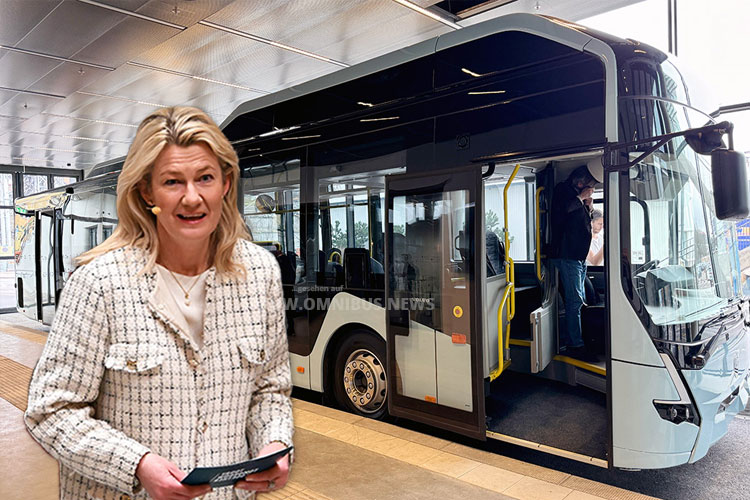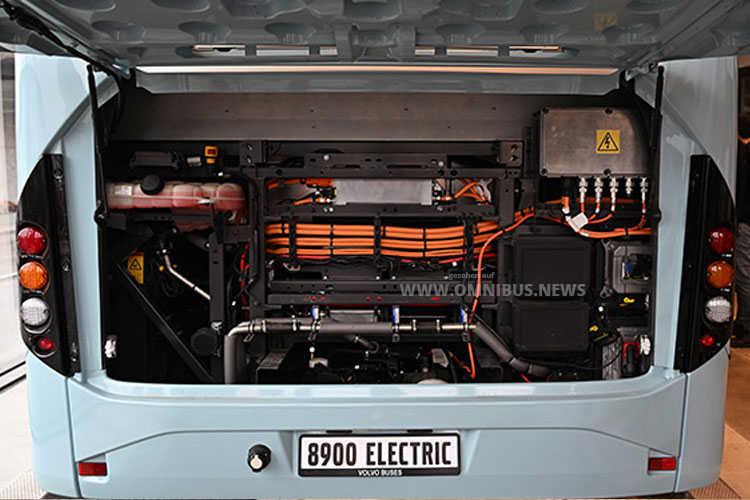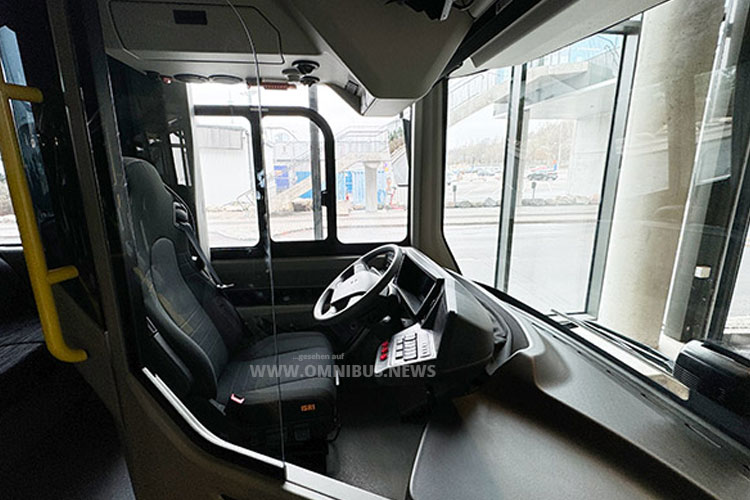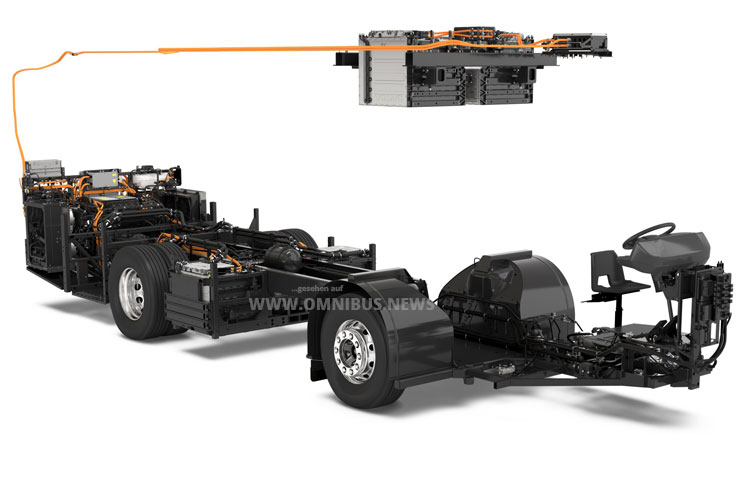
Anna Westerberg, President of Volvo Bus Corporation, presented a new electric intercity bus in Gothenburg last week. Photo: Massing; Montage: omnibus.news

At the start, Volvo Buses is relying on modules with four or six lithium-ion packs with a total capacity of up to 540 kWh. Larger battery capacities are to follow soon. Photo: Massing

The driver’s area and dashboard have been redesigned. Photo: Massing

It will be possible to obtain further battery packs in the near future. The placement of the battery packs is very flexible and can be designed to suit the application and structure. Photo: Volvo Buses
Iveco Bus presented the battery-electric Crossway LE at Busworld 2023 in Brussels. Solaris announced an E-InterUrbino for 2026 at the 2023 annual press conference. Volvo Buses is now following suit and presented the Volvo 8900 Electric intercity bus in Gothenburg last Wednesday.
The new electric intercity bus will be available in both Class 1 and Class 2, i.e. not only as a pure LE or high-floor intercity bus, but also as an LE city bus. According to Volvo Buses, the first Volvo 8900 Electric intercity buses will be available „in selected European markets in the course of 2025“.
The battery-electric intercity bus is based on the new electric chassis that has just been unveiled in Gothenburg, while the body for the Volvo 8900 Electric is produced by MCV. Volvo Buses has announced buses measuring 12.3 and 14.9 metres in length; the Swedes presented the three-axle LE variant at the premiere.
The new BZR base is exciting in the truest sense of the word, as it offers a flexible configuration, from low-floor to high-floor buses, with options for two or three axles and various battery configurations. During the premiere, Volvo Buses officials repeatedly emphasised that the BZR base reflects the company’s commitment to versatility and adaptability.
The drivetrain of the 8900 Electric is available with one or two motors, Volvo Buses stated 200 or 400 kW as performance data at the presentation. For the batteries, Volvo Buses relies on modules with four or six lithium-ion packs with a total capacity of up to 540 kWh.
Each battery pack has a capacity of 90 kWh. Volvo Buses attaches great importance to sustainable solutions, and the batteries could be reprocessed for other purposes or recycled when they have reached the end of their useful life in the bus. The batteries would come from the battery factory that the Volvo Group is building in Mariestad, the Swedes said at the première.
Charging takes place via a CCS connection, which can be installed on both sides of the bus, either at the front or rear. Charging is also possible via a pantograph (which is lowered onto the roof of the bus).
It will be possible to obtain additional battery packs in the near future. The placement of the battery packs is very flexible and can be designed to suit the application and structure. The batteries can be installed at various points on the chassis: on the sides, in the centre and even on the roof at the front of the bus.
The highlight is that the placement of the battery packs is very flexible and can be adapted to the needs and type of transport in which the bus is used or to a body manufacturer’s body. The batteries can be installed in various places on the chassis: on the sides, in the centre and even on the roof at the front of the bus. In the upcoming 7900 Electric low-floor bus, all batteries are located on the roof.
The Swedes have withdrawn from the complete bus business and want to capitalise on their brand image, their many years of experience with electric buses and their expertise as a chassis supplier throughout Europe. This places Volvo Buses below Daimler Bus or MAN, but clearly ahead of suppliers from the Middle Kingdom.
The new BZR platform provides for battery-electric buses with a length of 9.5 to 15 metres – and can also be used for coaches, although Volvo Buses does not currently see such a solution due to the battery capacity and range. Interesting: The new BZR platform is not directly prepared for fuel cells, the Swedes said on the sidelines of the premiere that the FC technology is not yet fully developed. And they are leaving the lead in the area of fuel cell operation to lorries.
Also interesting: the company does not want to close itself off from the market for electrically powered coaches, as Dan Pettersson, Senior Vice President and Head of Chassis Production at Volvo Buses, made clear at the première. And something else became clear:
The Volvo 8900 Electric is based on the electric bus base that Volvo Bus unveiled in 2020. It is now in operation in 25 countries across Europe. The 8900 Electric is intended for the intercity bus segment of the European market, but not for the whole of Europe: Germany is a market that is not at the top of the list.
More information on the passenger capacities, the planned lengths, equipment details and the design will be available shortly in another report on omnibus.news. (VolvoBuses/omnibus.news/PM/Sr)
Found an error in the article? Report it now!

Anna Westerberg, Präsidentin der Volvo Bus Corporation, hat letzte Woche in Göteborg einen neuen Elektro-Überlandbus vorgestellt. Foto: Massing; Montage: omnibus.news

Zum Start setzt Volvo Buses bei den Batterien auf Module mit vier oder sechs Lithium-Ionen-Paketen mit einer Gesamtkapazität von bis zu 540 kWh. Größere Batteriekapazitäten sollen zeitnah folgen. Foto: Massing

Der Fahrerplatz samt Armaturenbrett wurde neu gestaltet. Foto: Massing

In naher Zukunft werde es möglich sein, weitere Batteriepakete zu erhalten. Bei der Platzierung der Batteriepakete sei man sehr flexibel und könne entsprechend auf den Einsatz und Aufbau konstruktiv reagieren. Foto: Volvo Buses
Iveco Bus ist mit dem batterieelektrischen Crossway LE in Brüssel auf der Busworld 2023 vorgefahren. Solaris hat auf der Jahresbilanzpressekonferenz 2023 einen E-InterUrbino für 2026 angekündigt. Nun zieht Volvo Buses nach und präsentierte am vergangenen Mittwoch in Göteborg den Überlandbus namens Volvo 8900 Electric.
Der neue E-Überlandbus werde sowohl in der Klasse 1 als auch in der Klasse 2 erhältlich sein, also nicht nur als reiner LE- oder Hochboden-Überland- , sondern auch als LE-Stadtbus. Die ersten E-Überlandbusse des Volvo 8900 Electric werden laut Volvo Buses „im Laufe des Jahres 2025 in ausgewählten europäischen Märkten“ erhältlich sein.
Der batterieelektrische Überlandbus basiert auf dem in Göteborg jetzt vorgestellten neuen E-Fahrgestell, die Karosserie für den Volvo 8900 Electric stellt MCV her. 12.3 und 14.9 Meter lange Omnibusse hat Volvo Buses angekündigt, zur Premiere zeigten die Schweden die dreiachsige LE-Variante.
Die neue BZR-Basis ist im wahrsten Sinne spannend, denn sie bietet eine flexible Konfiguration, vom Niederflur- bis zum Hochflurbus, mit Optionen für zwei oder drei Achsen und verschiedenen Batteriekonfigurationen. Im Rahmen der Premiere betonten die Verantwortlichen bei Volvo Buses immer wieder, dass die BZR-Basis das Engagement für Vielseitigkeit und Anpassungsfähigkeit widerspiegle.
Der Antriebsstrang des 8900 Electric ist mit einem oder zwei Motoren erhältlich, Volvo Buses nannte anlässlich der Vorstellung 200 bzw. 400 kW als Leistungsdaten. Volvo Buses setzt bei den Batterien auf Module mit vier oder sechs Lithium-Ionen-Paketen mit einer Gesamtkapazität von bis zu 540 kWh.
Jeder Batteriesatz habe eine Kapazität von 90 kWh. Volvo Buses legt großen Wert auf nachhaltige Lösungen, und die Batterien könnten für andere Zwecke wiederaufbereitet oder recycelt werden, wenn sie ihre Nutzungsdauer im Bus beendet hätten. Die Batterien würden aus der Batteriefabrik stammen, die der Volvo-Konzern in Mariestad baue, so die Schweden bei der Premiere.
Das Aufladen erfolge über einen CCS-Anschluss, der an beiden Seiten des Busses angebracht werden könne, entweder an der Vorder- oder Rückseite. Außerdem sei das Laden über einen Stromabnehmer (der auf das Dach des Busses abgesenkt wird) möglich.
In naher Zukunft werde es möglich sein, weitere Batteriepakete zu erhalten. Bei der Platzierung der Batteriepakete sei man sehr flexibel und könne entsprechend auf den Einsatz und Aufbau konstruktiv reagieren. Die Batterien könnten an verschiedenen Stellen des Fahrgestells angebracht werden: an den Seiten, in der Mitte und sogar auf dem Dach an der Vorderseite des Busses.
Der Clou ist, dass die Platzierung der Batteriepakete sehr flexibel ist und an die Bedürfnisse und die Art des Verkehrs, in dem der Bus eingesetzt wird, oder an einen Aufbau eines Aufbauherstellers angepasst werden kann. Die Batterien können an verschiedenen Stellen des Fahrgestells angebracht werden: an den Seiten, in der Mitte und sogar auf dem Dach an der Vorderseite des Busses. Bei dem kommenden Niederflurbus 7900 Electric sind alle Batterien auf dem Dach untergebracht.
Die Schweden haben sich aus dem Komplettbusgeschäft zurückgezogen und wollen zukünftig vom Markenimage und der langjährigen Erfahrung mit Elektrobussen und der Kompetenz als Chassis-Lieferant europaweit punkten. Damit verortet sich Volvo Buses unterhalb von Daimler Bus oder MAN, sieht sich aber deutlich vor Anbietern aus dem Reich der Mitte.
Die neue BZR-Plattform sieht batterieelektrische Omnibusse mit einer Länge von 9,5 bis 15 Metern vor – und kann auch für Reisebusse verwendet werden, obwohl man bei Volvo Bus eine solche Lösung aufgrund der Batteriekapazität und der Reichweite derzeit nicht sieht.
Interessant: Die neue BZR-Plattform sei nicht direkt für Brennstoffzellen vorbereitet, die Schweden sagten am Rande der Premiere, dass die FC-Technologie noch nicht ganz ausgereift sei. Und man überlasse den Lastkraftwagen die Führung im Bereich des Brennstoffzellenbetriebs.
Auch interessant: Man wolle sich dem Markt für elektrisch angetriebene Reisebusse nicht verschließen, wie Dan Pettersson, Senior Vice President und Leiter der Fahrgestellproduktion bei Volvo Buses, anlässlich der Premiere deutlich machte. Und noch etwas wurde deutlich:
Der Volvo 8900 Electric basiert auf der Elektrobus-Basis, die Volvo Bus 2020 vorstellte. Mittlerweile sei man damit in 25 Ländern europaweit im Einsatz. Der 8900 Electric ist für das Segment der Überlandbusse des europäischen Marktes bestimmt, aber nicht für ganz Europa: Deutschland sei ein Markt, der nicht auf der Liste ganz oben stünde.
Mehr zu den Fahrgastkapazitäten, den geplanten Längen und sowie Ausstattungsdetails und dem Design in Kürze in einer weiteren Meldung auf omnibus.news. (VolvoBuses/omnibus.news/PM/Sr)
Fehler im Beitrag gefunden? Jetzt melden!
